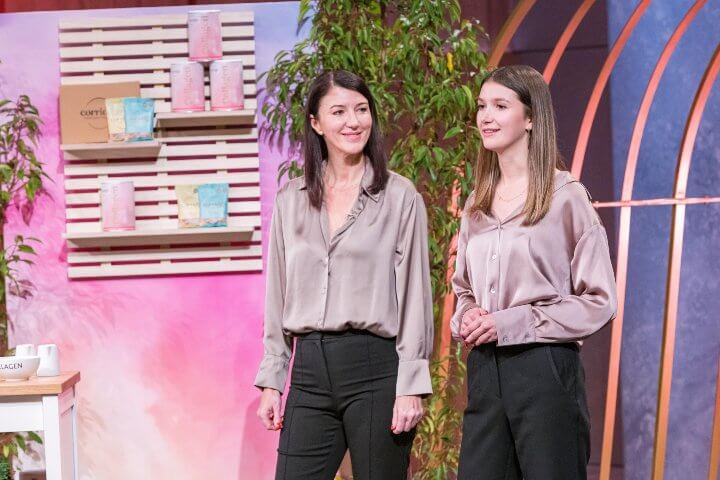Corridge: How do you build a USP? #DHDL
You often hear on ‘Die Höhle der Löwen’ that a USP is not strong enough. The famous ‘Unique Selling Point’ simply refers to the unique selling point of a product or other offering in its market. But how strong is strong enough?
Friday,
09.05.2025

On Monday, the mother-daughter team Mirjam and Ellen presented a portioned porridge with collagen to the lions. So you can do something for beautiful skin while eating breakfast.
However, even the relatively small deal of €50,000 for 20% did not result in cries of enthusiasm from the lions, as they quickly got hung up on two points:
Firstly, they considered the product to be quite expensive, or at least too expensive to reach a wider audience. Although the ratio of production costs to sales price per bag of around €1.10 to €2.99 was basically okay for such a young start-up, this was only because the sales price seemed quite high. This did not seem promising enough for the investors, especially for retailers.
On the other hand, there was a lot of discussion about the USP, and the final cut at least suggested that the founders were unable to provide a truly satisfactory answer. Although they tried to emphasise the special quality of their collage, this alone was too easy for the lions to copy. The combination with a porridge in a ready-made sachet for quick breakfast preparation didn’t really go down well either.
This discussion could easily make founders doubt whether their own USP is strong enough. Because if you follow these arguments, it would be very difficult for the vast majority of food start-ups to formulate a USP that is strong enough. After all, large corporations could copy their recipes or blends quite quickly.
But why do start-ups always manage to win the hearts of consumers after all? Is the fear of copying not so justified after all, or how can the success of various products on the food shelf be explained, for which the large corporations have not yet been able to provide any real competition?
If you take a closer look, these products are usually not exactly cheap, which is certainly due to the smaller quantities and therefore higher production costs, especially at the beginning. On the other hand, it is also simply due to the fact that start-ups in particular often operate in a market segment that fulfils consumer demand for higher quality – and in the food sector often healthier – alternatives. However, these customer groups are usually aware that quality usually comes at a higher price and they are often both more affluent and more willing to pay.
However, large corporations often have an image problem in these market segments: customers literally don’t buy their high quality and, above all, certain sustainability aspects – and prefer to trust small start-ups that their promises are not marketing lies. In fact, corporations have often had problems with acquired brands whose image did not survive the acquisition.
Of course, a USP is and remains one of the most important criteria for investors. Simply because a strong USP means poorer copyability and better marketing opportunities. Of course, this reduces the risk of a total failure due to suddenly blossoming competition that simply has better distribution, for example.
But shouldn’t a good early-stage investor also recognise a USP that may simply not have been communicated so well? Or even better: help a good team with potential in the product to build it?
If you listened closely to Corridge’s pitch, you may have picked up on a few key points that initially seem like a kind of ‘standard for food start-ups’. At least for those who want to establish themselves in the higher-quality market segment mentioned: no additives, no additional flavourings, no added sugar.
But are they really all so obvious? Anyone who has ever looked for a low-sugar and preferably high-protein porridge or muesli knows what a drama it can be. Less than 10g of sugar per 100g seems like a sheer impossibility in a normal supermarket.
But the Corridge Banana impresses with just 5g of sugar and over 23g of protein. For many nutrition-conscious cereal breakfast fans, this seems almost like a blessing and is certainly not a matter of course on the current market – and if it is available at all, it is usually not exactly cheap.
But lioness Janna Ensthaler had an even more far-reaching idea: how about taking the collagen muesli as a starting point and setting her sights on the grand vision of developing into a provider of porridge with added nutritional supplements? She saw more potential to build up a corresponding USP for this, but she also wanted 10% more shares in the food start-up.
The founders agreed, and the new products appear to be in development. If you now search for ‘porridge with collagen’, Corridge actually ranks at No. 1 in the unpaid search results on Google.
So it seems that the courageous investor is now also being rewarded with an original USP that is stronger than initially assumed.
Photo (above): TVNOW / Bernd-Michael Maurer

Ruth Cremer
Ruth Cremer is a mathematician and consultant as well as a university lecturer in the field of business models, key figures and financial planning. As a former investment manager, she knows what investors look for and also helps with pitch and document preparation in the investment or acquisition process. Since 2017, she is involved as an external consultant in the selection and preparation of the candidates in "Die Höhle der Löwen".
